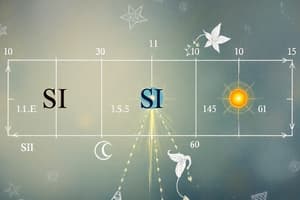Podcast
Questions and Answers
What is a primary requirement for a unit to be considered a standard unit for a physical quantity?
What is a primary requirement for a unit to be considered a standard unit for a physical quantity?
- It should have international acceptance. (correct)
- It is determined based on historical usage.
- It must be flexible in definition.
- It can be defined arbitrarily by each country.
Which organization is responsible for deciding standard units through international agreement?
Which organization is responsible for deciding standard units through international agreement?
- World Association of Measurement Standards
- General Conference on Weight and Measures (CGPM) (correct)
- International Bureau of Weights and Measures
- United Nations Standardization Committee
Which characteristic is NOT a requirement for a standard unit to ensure it is effective?
Which characteristic is NOT a requirement for a standard unit to ensure it is effective?
- Availability
- Accessibility
- Invariability
- Cultural significance (correct)
What does 'invariability' mean in the context of defining a standard unit?
What does 'invariability' mean in the context of defining a standard unit?
Why is it challenging to communicate measurements without a standardized system?
Why is it challenging to communicate measurements without a standardized system?
Which of the following is NOT a characteristic of Dr. Verma's book, "Concepts of Physics", as described in the foreword?
Which of the following is NOT a characteristic of Dr. Verma's book, "Concepts of Physics", as described in the foreword?
Based on the foreword, what is the primary intended audience for "Concepts of Physics"?
Based on the foreword, what is the primary intended audience for "Concepts of Physics"?
What is the central idea conveyed by the foreword's reference to Indian Philosophy & Way of Life?
What is the central idea conveyed by the foreword's reference to Indian Philosophy & Way of Life?
What aspect of Dr. Verma's book is NOT directly mentioned in the foreword as a reason for its potential usefulness?
What aspect of Dr. Verma's book is NOT directly mentioned in the foreword as a reason for its potential usefulness?
According to the foreword, what is the author's primary motivation in writing "Concepts of Physics"?
According to the foreword, what is the author's primary motivation in writing "Concepts of Physics"?
Which of the following statements about the SI units is not accurate based on the provided text?
Which of the following statements about the SI units is not accurate based on the provided text?
Which of these units is not defined in terms of a universal constant, according to the provided text?
Which of these units is not defined in terms of a universal constant, according to the provided text?
What is the primary reason for the redefinition of the SI base units as described in the text?
What is the primary reason for the redefinition of the SI base units as described in the text?
Which of these examples represents physical quantities with a wide range of magnitudes, as described in the text?
Which of these examples represents physical quantities with a wide range of magnitudes, as described in the text?
Which of the following statements can be inferred from the text about the redefinition of SI units?
Which of the following statements can be inferred from the text about the redefinition of SI units?
What is the value of one ampere in terms of elementary charge?
What is the value of one ampere in terms of elementary charge?
Which of the following units is equal to joules per kelvin (J·K^-1)?
Which of the following units is equal to joules per kelvin (J·K^-1)?
How many elementary entities are defined in one mole of a substance?
How many elementary entities are defined in one mole of a substance?
Which prefix corresponds to the factor of 10^-18?
Which prefix corresponds to the factor of 10^-18?
Which of the following represents the correct dimension for force in the MLT system?
Which of the following represents the correct dimension for force in the MLT system?
Flashcards
Dr. Harish Chandra Verma
Dr. Harish Chandra Verma
An author and retired professor who wrote 'Concepts of Physics'.
Concepts of Physics
Concepts of Physics
A textbook designed to teach physics concepts clearly and effectively.
Teaching Methodology
Teaching Methodology
Uses a structured approach with problems and objective questions to enhance learning.
Undergraduate Students
Undergraduate Students
Signup and view all the flashcards
Lucid Exposition
Lucid Exposition
Signup and view all the flashcards
International System of Units
International System of Units
Signup and view all the flashcards
CGPM
CGPM
Signup and view all the flashcards
Invariability in units
Invariability in units
Signup and view all the flashcards
Availability of units
Availability of units
Signup and view all the flashcards
Fundamental quantities
Fundamental quantities
Signup and view all the flashcards
Thermodynamic Temperature
Thermodynamic Temperature
Signup and view all the flashcards
Amount of Substance
Amount of Substance
Signup and view all the flashcards
Luminous Intensity
Luminous Intensity
Signup and view all the flashcards
Supplementary Units
Supplementary Units
Signup and view all the flashcards
SI Prefixes
SI Prefixes
Signup and view all the flashcards
Deci
Deci
Signup and view all the flashcards
12 pico
12 pico
Signup and view all the flashcards
Mole
Mole
Signup and view all the flashcards
Ampere
Ampere
Signup and view all the flashcards
Kelvin
Kelvin
Signup and view all the flashcards
Study Notes
Introduction to Physics
- Physics relies on standard units for international communication.
- Conférence Générale des Poids et Mesures (CGPM) sets international standards.
- The International System of Units (SI) is the system used globally.
- Table 1.1 lists the base quantities and their SI units.
- Supplementary units exist for plane and solid angle.
Fundamental Units Definitions
- SI base quantities are defined in terms of universal constants with fixed values, ensuring invariability and availability.
- This new definition became operative in May 2019.
- The definitions incorporate concepts beyond this book's scope, but not required for the user to understand
SI Prefixes
- Prefixes denote multiples and submultiples of SI units.
- Examples include deci (d), centi (c), milli (m), micro (µ), nano (n), pico (p), femto (f), atto (a).
Definitions of Base Units
- Standard units must be invariable and readily available.
- The current definitions meet these criteria, defining units in terms of constants.
Dimensional Analysis
- Dimensional analysis checks if equations are dimensionally consistent; a dimensionally incorrect equation is wrong.
- Dimensionally consistent equations might not be accurate.
- Dimensions can be used to derive relationships.
Example 1.2 (Dimensional Analysis)
- Time period (t) = 2π√(m/F).
- Determining if time period formula is dimensionally correct.
- Dimensions for the right-hand side are:
- The left-hand side units are time, thus, both sides have equal units.
Limitations of the Dimensional Method
- Dimensional analysis can't find all relations.
- It depends on knowing the physical quantities involved in the relation and assuming simple product type dependency.
- Numerical constants are not deducible using this method.
- Example: Distance can't exclusively be calculated by this method.
Order of Magnitude Estimation
- Order of magnitude estimation approximates physical quantities to powers of 10 for approximate calculations.
- An example is estimating the number of people in a circular field.
Studying That Suits You
Use AI to generate personalized quizzes and flashcards to suit your learning preferences.




